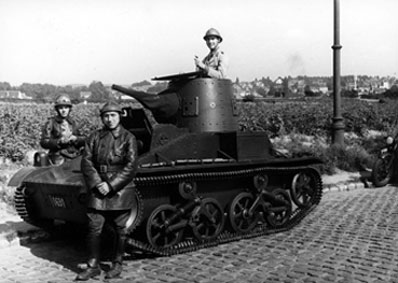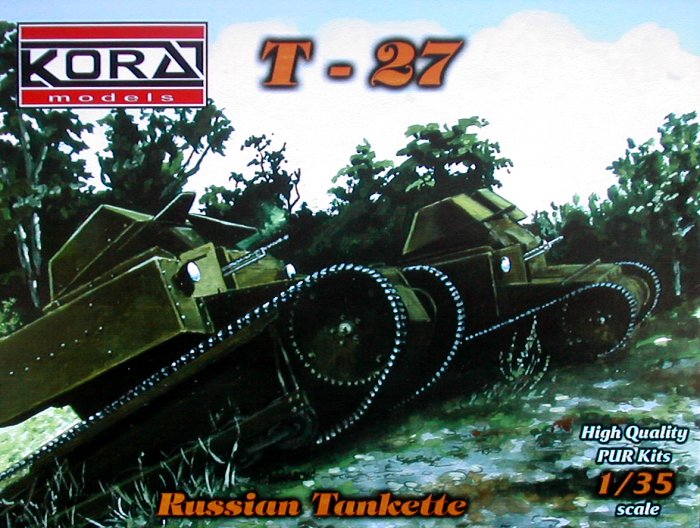Garden malli osoittautui testeissä paremmaksi ja he ryhtyivät valmistamaan yhdessä
Loyd omistamassa tehtaassa. Hieman myöhemmin tehtaan osti Vickers-Armstrong.
1928 valmistui ensimmäinen Garden-Loyd Mark IV, yhdellä konekiväärillä aseistettu tankki.
1930 Neuvostoliitto osti 26 tälläistä vaunua ja lisenssi-valmistus oikeudet.
Mark IV vaunuja myytiin moneen maahan.

Yksi Mark IV vaunu ostettiin Suomeen kokeiltavaksi.
Tämä vaunu on Parolan Panssari museossa, kunnostettu, lähes ajokuntoinen.

![[IMG]](http://img853.imageshack.us/img853/1421/v42864tksprot.jpg)



Puola valmisti vaunua: TE 1, TE 3, TKW, YKS, TKZ, TKS, TKD ja TKF tyyppi nimillä.


![[IMG]](http://img715.imageshack.us/img715/6784/bundesarchivbild101i201.jpg)

Italia valmisti: CV 29, CV 3; CV 33 ja CV 35 tyypit


Tsekkoslovakia: Skoda MU tyyppi.

Ranska: Renault UE tyyppi.


Belgia: Char leger T 15 tank

Saksa valmisti vaunua version Panzer I / Kleinwagen, Panzerkampfwagen-I
Panzer-Befehlswagen I Ausf B Kleiner Panzer Befehlswagen I (Sd.Kfz.265)




------------

Light Tank Mk.VIC and Light Tank AA Mk.I

-----------



Britannia valmisti armeijalle satoja panssarivaunuja vuosi 1940 mennessä
Light Tank Mk VIA-2
Pituus: runko: 4,0 m
Leveys: 2,08 m
Korkeus: 2,26 m
Taistelupaino: 4,93 t
Maksiminopeus: Tiellä: 56 km/h, maastossa 40 km/h
Toimintasäde:210 km
Aseistus: 1 x .50" Vickers-konekivääri 1 x.303" Vickers-konekivääri
Panssarointi: 4-14 mm
Moottori: 6-sylinterinen Meadows-moottori 88 hv
Miehistö: 3.
Toukokuu 1940 Ranska. Mark IV - vaunuja oli Englantilaisten käytössä 210 kpl

Neuvostoliitto aloitti Licht Mark IV lisenssi-vaunujen valmistuksen vuosi 1931.
Neuvostoliitossa tyyppi-nimi oli T-27.
Näiden vaunujen valmistus jatkui vuosi 1939 asti.
Vaunuja valmistui noin 4000 kpl.
Following the activities of the Experimental Mechanized Force in the late 1920s, the British Army identified a need for two light tracked vehicles; one to carry a machine gun for the infantry and one with a turret for the Royal Tank Corps.
The Carden-Loyd tankette became the infantry vehicle, at the same time Carden developed privately a number of light two-man tank designs.
Carden's Mark VII design was accepted as a prototype for the Army's light tank. By that point Carden-Loyd was part of Vickers-Armstrong. Only a few of the first light tanks were built and although never issued per se gave useful information for subsequent development.
The Mark VII was a small machine gun-armed vehicle with a 59 hp Meadows engine which gave it maximum speed of 35 mph (56 km/h). Suspension was two two-wheel leaf sprung bogies either side with an external girder to give the suspension strength.
Light tanks of the United Kingdom
The basic form of the Light Tank was used by Vickers for export markets. This included the 1933, 1934, 1936 and 1937 models. Buyers included Finland, Lithuania, Latvia, Argentina, Belgium, Switzerland, the Netherlands, Dutch East Indies and China.
Forty-two were produced for Belgium in 1935, based on the Mark III with a different turret on request of the Belgium armed forces. Armed with a French 13.2 mm Hotchkiss machine gun, they were designated T-15 Light tank by the Belgians
The Netherlands ordered some of the 1936 Model. Those which were not delivered by the outbreak of the Second World War were taken into service with the British Army as the "Tank Light, Vickers Carden Loyd, Model 1936"
In practice they were referred to by the nickname "Dutchmen".
Ei kommentteja:
Lähetä kommentti
Any explosive ammunition or empty cores, you can put in this.